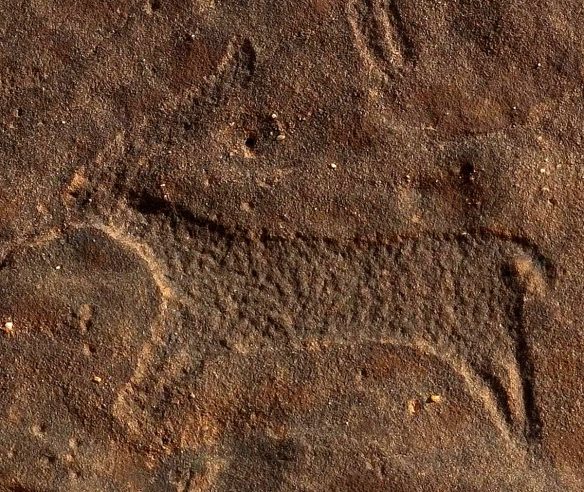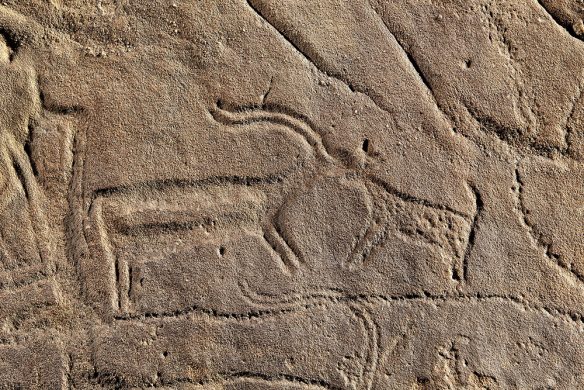[Page 1]Abstract: In 1 Nephi 16:13–14, Nephi mentions the name Shazer as a toponym the Lehite clan bestowed on a site in western Arabia “four days” journey south-southeast of the valley of Laman. The Lehites used this site as a base camp for a major hunting expedition. A footnote to the first mention of the name Shazer in the 1981 and 2013 Latter-day Saint editions of the Book of Mormon has virtually enshrined “twisting, intertwining” as the presumed meaning of this toponym. However, the structure of Nephi’s text in 1 Nephi 16:12–13 suggests that the name Shazer serves as the bracketing for a chiastic description of the Lehites’ hunting expedition from the site. This chiasm recommends hunting as a possible starting point for seeking a more precise etymology for Shazer, one related to food supply. Consequently, I briefly argue for Shazer as a Semitic word (possibly also a loanword from an Old Arabic dialect) and a close cognate with both Hismaic šaṣar (“young gazelle,” plural šaṣr) and Arabic šaṣara (a type of “gazelle”).
The name Shazer represents one of only a handful of toponyms (place names) Nephi mentions in his small plates account of his family’s journey through the Arabian wilderness. Nephi reports that after the family finally broke camp and left the Valley of Lemuel, “we did take our tents and departed into the wilderness across the river Laman. And it came to pass that we traveled for the space of four days nearly a south- southeast direction. And we did pitch our tents again” (1 Nephi 16:12–13).1 At this point, Nephi notes that the Lehite clan gave the site of their camp the name “Shazer”:
[Page 2]A [A]nd we did call the name of the place Shazer.
B And it came to pass that we did take our bows and our arrows and go forth into the wilderness
C to slay food for our families.
C′ And after that we had slain food for our families,B′ we did return again to our families in the wilderness
A′ to the place of Shazer.2 (1 Nephi 16:13–14; emphasis in all scriptural citations added)
Lehi’s family undoubtedly relied on hunting for food, including the hunting of gazelles, during the early stages of their journey, though he does not mention such until 1 Nephi 16:13–14. In that passage, Nephi explicitly describes Shazer as a base camp for a major hunting expedition undertaken (presumably) by the adult men in the clan.3 Nephi frames his description of this wilderness hunting expedition using the name Shazer, which he mentions twice. Although Nephi does not give an explicit etiological explanation for their naming of Shazer (“and we did call the name of the place Shazer,” v. 13), the chiastic structure of Nephi’s mention of Shazer suggests that its naming may be connected with the party’s hunting activities around that location.
Once this major hunting expedition was complete, Nephi states that the Lehite clan “did go forth again in the wilderness, following the same direction [i.e., south-southeast], keeping in the most fertile parts of the wilderness which was in the borders near the Red Sea” (1 Nephi 16:14). He further mentions that they “did travel for the space of many days, [Page 3]slaying food by the way with our bows and our arrows and our stones and our slings” (1 Nephi 16:15). However, Nephi’s twofold mention of Shazer and the hunting of “food” that took place in the wilderness near that place raises the question: what, if anything, might the name Shazer have to do with the food they hunted? In fact, “food” is mentioned thirteen times in connection with the key events detailed in 1 Nephi 16, and it becomes a key word in the pericope. Nephi’s long sequence of “food” mentions in 1 Nephi 16 begins with the naming of Shazer and the hunting done near that location.
The Meaning of Shazer
A footnote to the first mention of the name Shazer in 1 Nephi 16:13 in the 1981 and 2013 editions reads: “HEB twisting, intertwining.” This footnote follows Sidney B. Sperry’s suggestion that the name derives from the Hebrew root *šzr.4 Paul Hoskisson cites the foregoing in the Book of Mormon Onomasticon as “[t]he most likely suggestion” but rightly cautions that this root “only appears in the hophal participle [form] in the Hebrew Bible.”5 In other words, Sperry was arguing for an active form of the root *šzr that is thus far unattested in Biblical Hebrew. Nevertheless, Sperry’s suggestion is not without merit.
Another widely cited explanation for Shazer is Hugh Nibley’s suggestion that it derives from Arabic shajer:
The combination shajer is quite common in Palestinian place names; it is a collective meaning “trees,” and many Arabs (especially in Egypt) pronounce it as shazher. It appears in Thogret-as-sajur (the Pass of Trees), which is the ancient Shaghur, written Segor in the sixth century. It may be confused with Saghur “seepage,” which is held to be identical with Shihor, the “black river” of Joshua 19:36. This last takes, in western Palestine, the form of Sozura, suggesting the name of a famous waterhole in South Arabia, called Shisur … So we have Shihor, Shaghur, Sajur, Saghir, Segor (even Zoar), Shajar, Sozura, Shisur, and Shisar, all connected somehow or other [Page 4]nd denoting either seepage — a weak but reliable water supply — or a clump of trees.6
Although Nibley’s numerous suggestions are all appropriate for a desert and Near Eastern/Arabic context in general, none closely approximates Shazer as a Judahite of the sixth century BCE would have pronounced it (shah-zer, shah-tzer, or shah-dzer). Moreover, Lehi and his family were traveling south-southeast through the northern part of the Arabian Peninsula rather than through modern Palestine or Egypt; they were not traveling at this particular stage of their journey through South Arabia. Because they are removed from the Lehites’ journey in time and space, Nibley’s suggestions are less compelling.
While the Lehites’ creation of a toponym based on the presence of trees or a water supply would certainly make sense, other possibilities are equally plausible. For instance, it is possible that the Lehites created a toponym based on the supply of food at the site. In another instance of Lehite toponymy on the Arabian Peninsula, Nephi reports that the Lehites named “Bountiful” on the basis of the abundance of food that they found there:
And we did sojourn for the space of many years, yea, even eight years in the wilderness. And we did come to the land which we called Bountiful because of its much fruit and also wild honey. And all these things were prepared of the Lord that we might not perish. And we beheld the sea, which we called Irreantum, which being interpreted is many waters. And it came to pass that we did pitch our tents by the seashore. And notwithstanding we had suffered many afflictions and much difficulty, yea, even so much that we cannot write them all, we was exceedingly rejoiced when we came to the seashore. And we called the place Bountiful because of its much fruit. (1 Nephi 17:4–6)
Here the Lehites name a particular land Bountiful because of its abundance of fruit and honey. Nephi subtly connects this abundance of food with the abundance of difficulties they faced on their journey to arrive there as well as their overwhelming joy upon arrival. The placement of the name Bountiful in this passage suggests that it may be an emphatic bracketing device (albeit bracketing a less chiastic text) describing a Lehite food gathering expedition — similar to the dual use [Page 5]of the name Shazer in 1 Nephi 16:13-14 quoted above. There is a firm basis in the text structure in 1 Nephi 16:13–14 and in the foregoing Bountiful analog (1 Nephi 17:5–6; cf. 18:6) for such a suggestion.
There is also a strong, if not compelling, philological basis to suggest connecting Shazer with food. Surprisingly, amid all the discussion of Shazer as a derivation from a Hebrew š-z-r root, few if any have given consideration of the –z– as transliteration of the phoneme –ṣ– (tz — i.e., a tzaddi), which is also frequently transliterated into English and other western languages as a ‘z.’ Here Hismaic (or Hiṣmaic), a dialect of pre- Islamic Old Arabic spoken in the very area of the Arabian peninsula through which Lehi and his family traveled, offers a more promising possibility. Geraldine Margaret Harmsworth King points out that Hismaic inscriptions abundantly attest the term šṣr/šaṣar (or s²ṣr, pl. šaṣr or ʾašṣār), which she glosses as “young gazelle.”7 King lists the plural form of šṣr/šaṣar (or s²ṣr) as šaṣr or ʾašṣār (“young gazelles”).8 Hans Wehr glosses the Arabic cognate šaṣara as “a kind of gazelle.”9 If not a part of their own Hebrew lexical resources, the Lehites may have borrowed a form of šṣr from neighboring northern Old Arabic-speaking nomads, either before or during the early part of their journey into Arabia. Notably, šṣr (s²ṣr) is further attested as a personal name in Safaitic10 inscriptions held in the Al-Mafraq Museum (Al-Mafraq, Jordan), inscriptions 47–48:
[Page 6]No. 47: l s²ṣr bn qtl bn s¹ḥly bn mr bn ʾft
“By S²ṣr son of Qtl son of S¹ḥly son of Mr son of ʾft”
No. 48: l mty bn s²ṣr
“By Mty son of S²ṣr.”11
At a minimum, it is clear that Shazer as šṣr (s²ṣr) shows up as a proper noun in the near vicinity of northern Arabia.12 Perhaps it is also worth mentioning that other possible cognates of this lexeme show up in other Semitic contexts.13
Additionally, note that the modern English noun “gazelle” ultimately derives from Arabic ġazāl. This term and its cognates have a venerable history within the family of Semitic languages. Cognate with this Arabic noun is the Akkadian noun ḫuzālu/uzalu (“a gazelle kid,” which is also attested as a personal name).14 The vacillation between ḫ and u (ø) in the Akkadian (Old Babylonian) lexeme suggests that Western Semitic (“Amorite”) personal names “ḫa-za-la and a-za- lu-um” were pronounced “/ǵazāl-/ ‘gazelle'” and “ḫu-za-lum and ú-za-lum” were pronounced “/ǵuzālum/ ‘little gazelle.'”15 Similarly, Ugaritic attests the personal name ġzl(y),16 a name similar or identical to the former in form and meaning to the “Amorite” manifestation of this name. Thus, both šṣr (s²ṣr) and ġzl(y)/ǵuzālum constitute attested proper names with the probable meaning “gazelle.”
[Page 7]If Shazer, šṣr, and šaṣara as “(young) gazelle” can be connected with the Hismaic verb šaṣara, to “sew a garment with stitches widely spaced,”17 perhaps these terms connect back on some level to Sperry’s initial suggestion (“to spin, to twist”)18 from the verb *šzr, “to twist, to intertwine [threads]” (cf. Arabic šazara “to spin threads together, twist”).19 Indeed, Sperry’s derivation of Shazer from Hebrew *šzr may have an archaic etymological relationship to Old Syrian *ɣzl (to “spin”) and ɣzl (“[small] gazelle”) (cf. Proto-Semitic ɣVzāl, “gazelle”). Arabic ġazāl (“gazelle”)20 and ġazāla (“female gazelle, doe”)21 both derive from the Arabic verb ġazala, “to spin”22 (cf. Ugaritic ġzl, “spinner,”23 and Syriac ʿzl, “to spin, weave”).24 The analogical relationship here — between the Hismaic šṣr/šaṣara (noun = “[young] gazelle”) and šaṣar/šazara (verb = “sew,” “spin”) on the one hand, and between the Arabic ġazāl/ɣzl (noun = “[small] gazelle”) and ġazala/ɣzl (verb = “spin”) on the other should be clear. This relationship further raises the issue of whether gazelles — ġazāl and šṣr — were so named because of their ability to traverse or “thread” difficult wilderness terrain, such as is often found in the ancient Near East, like a “spinner” or one who “sews” and “weaves.”25 Whatever the case, there appears to be a strong philological case for identifying Shazer with a close cognate of šṣršaṣar and šaṣara, as well as a loanword form a local northern Old Arabian dialect. And such a name, connected with the gazelle, is appropriate for both the time and place described in Nephi’s narrative.
[Page 8]Gazelles as a Lehite Food Staple in Arabia
Mohammed Maraqten states that “the gazelle … was the favoured and most attested hunted animal in Central and North Arabia.”26 It is highly likely that gazelle meat constituted a main dietary staple for Lehi and his family while in the Arabian wilderness. Deuteronomy 14:5 lists one term for gazelle (ṣĕbî, KJV “roebuck”), a genus to which the šṣr or šaṣar (“young gazelle”) would belong or share a close relationship, as among the “clean” animals permitted for food. This “Kosher” consideration, to use an anachronistic term, makes the case even more likely. Not every animal would have been fit for consumption under the dietary statutes of Leviticus 11 and Deuteronomy 14, but indigenous Arabian gazelles would not have presented that problem since all species of gazelle have cloven hooves and chew the cud as indeed all ruminants27 do (see again the ṣĕbî [“roebuck” = gazelle] as one of ten cud-chewing, cloven-hoofed “clean” animals listed in Deuteronomy 14:4-6).28
Types of Gazelles Near Shazer
Davida Eisenberg-Degen and Steven A. Rosen observe that “the osteological evidence points toward gazelle being the most hunted animal from the Chalcolithic/Early Bronze age”29 (and onward) in the Negev, or southern Judean wilderness, through which the Lehites passed on the initial stage of their journey into Arabia. The practice of hunting gazelles (among other animals like the ibex and the oryx) would have continued as the journey into Arabia progressed. Maraqten further remarks that the [Page 9]hunting of gazelles in the Arabian Peninsula “was practiced and remained a dominant economic activity, perhaps from Neolithic to the Bronze age and continued to be practiced until recent times.”30

A gazella marica found in ancient rock art.31
Once Lehi’s party had entered the Arabian peninsula, the most common types of gazelle they inevitably encountered, either “by the way”32 or during more protracted hunting expeditions, would have been the gazella marica (the Arabian sand gazelle), the gazella Arabica (the Arabian gazelle, including the mountain gazelle and gazella erlangeri subspecies), and now-extinct native forms of the gazella dorcas (gazelle dorcas, including the gazella dorcas saudiya or gazella saudiya).33 The [Page 10]noun šṣr (s²ṣr), as a “young gazelle” would plausibly describe any of these, unless it had a more specific reference.

A gazella dorcas saudiya found in ancient rock art.34
Of these, populations of gazella marica — based on current population patterns35 — would have been closest to Shazer in northwest Arabia, and thus perhaps the most plentiful as a food source for the Lehites.
Conclusion
Nibley is certainly correct that “the name [Shazer] is intriguing.”36 I have briefly attempted to make the case here that Shazer constitutes a Semitic term, possibly borrowed from Old Arabian, and closely related to Hismaic šṣr or šaṣar (s²ṣr), “young gazelle” and Arabic šaṣara, “a kind of gazelle.” Such a derivation fits an Arabian wilderness context at least as well as Nibley’s shajer suggestion and better fits the immediate circumstances of the family as described by Nephi in his small plates record (though Nibley’s suggestion cannot be entirely ruled out). In any case, there is strong philological evidence to connect the Lehite toponym Shazer with the gazelles of the Arabian peninsula — the gazelles that would have surely constituted an important staple of the party’s diet as they travelled south-southeast down that peninsula, and after they turned east at Nahom (see especially 1 Nephi 17:1–2).
[Page 11]

Sand gazelle37
[Author’s Note: I would like to thank the Layan Cultural Foundation for their generosity and kindness in allowing the use of their superb photography. I would also like to thank Suzy Bowen, Allen Wyatt, Daniel C. Peterson, and Victor Worth.]
s²ṣr See s²ṣr, pl. šaṣr, ʾašṣār “young gazelles”: Hismaic KJA 16, KJA 53, KJA 207, KJB 151, KJB 155, KJC 248, KJC 278*, KJC 287, KJC 565, KJC 661.
s²ṣr šaṣara “sew a garment with stitches widely spaced”, šaṣar “young gazelle”; HIn 348 Saf.; Hismaic KJA 242, KJB 58, KJB 59, KJC 654, TIJ 82, TIJ 199 + TIJ 201, TIJ 238, TIJ 290, TIJ 452, TIJ 463. -fa. of ḥrzt TIJ 82, TIJ 290



Go here to see the 13 thoughts on ““Shazer: An Etymological Proposal in Narrative Context”” or to comment on it.